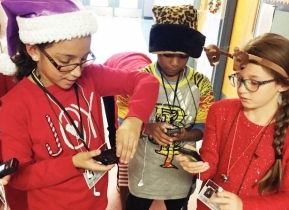'Walking classroom' helps kids learn while exercising
By Phyllis Moore
Published in News on December 28, 2015 1:46 PM

News-Argus/PHYLLIS MOORE
Carver Elementary School fourth-graders Karen Compean and Jocelyn Bond sync up their devices for a podcast as part of the "walking classroom."
There's another way to teach kids that doesn't involve a desk, book, pencil or paper.
Instead it burns off extra energy and fits all learning styles.
In the "walking classroom," students just need an MP3-type player and some earbuds. And the ability to walk and listen at the same time.
"Students take 20-minute walks as a class while listening to fun, kid-friendly podcasts," explained Robin Casey, fourth-grade teacher at Carver Elementary School in Mount Olive, who wrote a grant two years ago and has been incorporating the program ever since.
"The content is aligned with the Common Core State Standards for fourth and fifth grades but topics are appropriate for those in grades 3-8."
Lessons are available in grammar, writing, reading and social studies, she said. Currently, 48 states are using the "walking classroom."
The daily ritual -- at least for two or three months, then the shared equipment rotates to another fourth-grade class -- can be done on the "outdoor pathway" or indoors, depending upon the weather.
It has proven effective in a variety of ways, she said.
"We have four ways to make connections -- text to text, text to self, text to world and text to media," she said. "And so whenever we're doing a story, or even if we're listening to this, I'll say, 'Now what connections did you make?' They'll say, 'I remember when we read' or 'I remember when I saw' or 'I remember when we watched' so I always talk to them in those four ways, those connections."
It took time to train both the teachers and students, but has been paid off, she said.
"As a teacher, you know, you hate to say, 'Gosh, it's one more thing' but my philosophy is, if it's one more thing that benefits the kids, that gives them another skillset in place, then it's worth it," she said. "It only takes 20 minutes out of my day.
"I don't want to take away from recess so we use part of our instructional time and about 10 minutes of recess. I think it's very beneficial. I see it as another pathway for learning."
Fourth-grade teacher Michelle Holland says it is easy to incorporate the program into her routine.
"What I liked about it was each one of the podcasts had lesson plans with it, questions that you can ask before, questions you can ask after," she said. "You can give them a little quiz. And I didn't go in order of the pods. I picked out what I needed."
She also believes the students have adapted well to the system.
"I liked it because you have an ADD or ADHD child and you start the morning off, I did mine first thing in the morning, it burned off some of that excess energy and they were ready, and it even woke up the other kids. You know, they come in dragging in the morning," she said. "So it's a wonderful program. It's just trying to fit it all in."
Mandy Scott, another fourth-grade teacher, said students also take on leadership roles -- trained to be at the front of the line or as the "caboose" making sure everyone is where they need to be.
"And then we did signals, like hand signals for when they started their actual lessons -- hand signals for when we start the lessons, for when we need to slow down because there's another class coming or their signal to me when everybody was done," she said. "Depending on where we finished the lesson, sometimes we stop in front of the library and all of us would sit in a little huddle and we would have a class discussion back and forth about what the lesson was and I would ask them questions and they would ask each other questions related to that lesson and try to answer it."
There's a certain kind of question students are taught to ask, Mrs. Casey pointed out.
"Thick questions," her students replied in unison.
"You have to dig deep," explained student Hunter Merritt. "You have to really think hard about what the question is asking about."
It is an innovative way to listen and learn, the students agreed.
"It helps you learn some different lessons that we didn't know," said fourth-grader Karen Compeon. "You also pump your arms to get your heart rate going."
"The walking part of it, I'm glad I'm burning calories," added Zaheem Blanding. "It's good exercise and it's fun to do."
